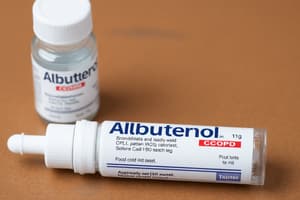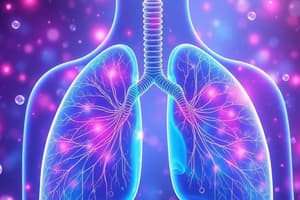Podcast
Questions and Answers
Which of the following best describes the mechanism of action of albuterol?
Which of the following best describes the mechanism of action of albuterol?
- Antagonizes the effects of histamine on H1 receptors.
- Selectively stimulates beta-2 adrenergic receptors, leading to bronchodilation. (correct)
- Inhibits GABA receptors in the central nervous system.
- Blocks acetylcholine receptors in the respiratory tract.
Albuterol is indicated for which of the following conditions?
Albuterol is indicated for which of the following conditions?
- Treatment and prevention of bronchospasm in patients with reversible obstructive airway disease. (correct)
- Treatment of inhaled airway irritants only.
- Persistent bronchospasm only.
- COPD exacerbation only.
Which of the following is a contraindication for albuterol administration?
Which of the following is a contraindication for albuterol administration?
- Hyperkalemia.
- Known hypersensitivity. (correct)
- Bronchospasm.
- Respiratory distress.
What is the typical onset of action for nebulized albuterol?
What is the typical onset of action for nebulized albuterol?
Ipratropium bromide is contraindicated in patients with a known hypersensitivity to which of the following?
Ipratropium bromide is contraindicated in patients with a known hypersensitivity to which of the following?
What is the mechanism of action of ipratropium bromide?
What is the mechanism of action of ipratropium bromide?
Diphenhydramine's primary mechanism of action involves:
Diphenhydramine's primary mechanism of action involves:
Which of the following is a contraindication for diphenhydramine?
Which of the following is a contraindication for diphenhydramine?
Diazepam is classified as which type of drug based on its primary action?
Diazepam is classified as which type of drug based on its primary action?
Which of the following describes the mechanism of action of diazepam?
Which of the following describes the mechanism of action of diazepam?
Flashcards
Albuterol: Mechanism of Action
Albuterol: Mechanism of Action
Short-acting beta-2 adrenergic agonist that causes bronchia smooth muscle relaxation and inhibits mediator release from mast cells.
Albuterol: Indications
Albuterol: Indications
Treatment and prevention of bronchospasm, treatment of inhaled airway/respiratory irritant agents and hyperkalemia treatment.
Albuterol: Contraindications
Albuterol: Contraindications
Known hypersensitivity, dysrhythmias and synergistic with other sympathomimetics.
Ipratropium Bromide: Mechanism of Action
Ipratropium Bromide: Mechanism of Action
Signup and view all the flashcards
Ipratropium Bromide: Indications
Ipratropium Bromide: Indications
Signup and view all the flashcards
Diphenhydramine: Mechanism of Action
Diphenhydramine: Mechanism of Action
Signup and view all the flashcards
Diphenhydramine: Indications
Diphenhydramine: Indications
Signup and view all the flashcards
Diazepam: Mechanism of Action
Diazepam: Mechanism of Action
Signup and view all the flashcards
Diazepam: Indications
Diazepam: Indications
Signup and view all the flashcards
Diazepam: Contraindications
Diazepam: Contraindications
Signup and view all the flashcards
Study Notes
Albuterol
- Bronchodilator with brand names Proventil, Ventolin, Proair, and Accuneb.
- It is classified as a sympathomimetic, bronchodilator, and short-acting beta-2 adrenergic agonist.
- Mechanism of action involves selectively stimulating beta-2 adrenergic receptors causing bronchial smooth muscle relaxation and inhibits mediator release from mast cells.
- Treats and prevents bronchospasm in patients with reversible obstructive airway disease, inhaled airway/respiratory irritant agents, and hyperkalemia.
- Contraindicated in individuals with known hypersensitivity and should be used cautiously with dysrhythmias or in conjunction with other sympathomimetics.
Albuterol Dosage and Administration (Adult)
- For respiratory distress, 2.5 to 5 mg via nebulizer or 1 to 2 inhalations (90 to 180 mcg) by MDI.
- For respiratory distress with bronchospasm signs, administer 5 mg via nebulizer or 6 puffs via MDI.
- For hyperkalemia, use 5 mg via nebulizer.
Albuterol Dosage and Administration (Pediatric)
- Administer 4 to 8 puffs with MDI every 20 minutes.
- If the child weighs less than 20 kg, give 2.5 mg/dose via nebulizer; if more than 20 kg, give 5 mg/dose via nebulizer.
- For respiratory distress with bronchospasm signs, administer 5 mg via nebulizer or 6 puffs via MDI.
Albuterol Duration of Action
- Has an onset of 5 to 15 minutes.
- Reaches peak effect in 30 minutes to 2 hours.
Ipratropium Bromide (Atrovent)
- Anticholinergic, bronchodilator, and short-acting antimuscarinic agent.
- It acts by antagonizing acetylcholine's effects on bronchial smooth muscle.
- Treats persistent bronchospasm, COPD exacerbation, and toxic inhalation (with albuterol).
- Should not be used when hypersensitive to ipratropium, atropine, alkaloids, or peanuts.
- Exercise caution in patients with urinary retention, narrow-angle glaucoma, cardiovascular disease, or hypertension.
- Common adverse effects include headache/dizziness, nervousness, tremor, dyspnea, worsening COPD symptoms, hypertension, tachycardia, palpitations, flushing, MI, dry mouth, nausea, vomiting, and GI distress .
- Potential for additive anticholinergic effects if administered with other antimuscarinic or anticholinergic medications.
- Adult and pediatric dose is 0.5 mg nebulized for up to three doses, which can be administered in conjunction with albuterol.
- Onset of action is 5 to 15 minutes, peak effect is 1.5 to 2 hours, and duration is 4 to 6 hours.
- Pregnancy safety category B, shake well before use, and avoid giving to children with bronchiolitis in the prehospital setting.
DiphenhydrAMINE (Benadryl)
- Antihistamine (H1 blocker).
- It blocks H1 receptors in the respiratory tract, blood vessels, and GI smooth muscle.
- It reverses extrapyramidal reactions.
- Indicated for symptomatic allergic reactions, symptomatic dystonia antiemetic, and extrapyramidal signs or symptoms caused by phenothiazines.
- Should not be used in individuals with hypersensitivity, newborns and premature infants, and breastfeeding mothers.
- Use with caution in patients with severe vomiting, asthma, narrow-angle glaucoma, benign prostatic hypertrophy, or alcohol intoxication, and use is controversial in patients with lower respiratory tract disease.
- Adverse effects include drowsiness, sedation, seizures, dizziness, headache, blurred vision, wheezing, thickening of bronchial secretions, palpitations, hypotension, dysrhythmias, dry mouth, diarrhea, nausea/vomiting, hallucinations, confusion, and paradoxical CNS excitation (especially in children).
- Potentiates the effects of alcohol and other CNS depressants, and MAOIs prolong and intensify anticholinergic effects.
DiphenhydrAMINE (Benadryl) Dosage and Administration
- For adults with urticaria or pruritus, anaphylaxis, or allergic reaction 1 mg/kg up to a maximum 50 mg dose IM, IV, or orally.
- The adult antiemetic dose is 12.5 to 25 mg IV/IM or orally.
- To treat dystonic/extrapyramidal symptoms, administer 25 to 50 mg IV/IM.
- Children with the same allergic ailments give 1 mg/kg up to a maximum 50mg IM, IV, or orally.
- For children older than age 2 and weight greater than 12 kg, the antiemetic dose is 0.1 mg/kg IV (maximum: 25 mg).
- For pediatric dystonic/extrapyramidal symptoms, give 1 to 1.25 mg/kg IV/IO or IM (25 mg maximum single dose).
- For chemical restraint, 1 mg/kg IM/IV or orally (25 mg maximum dose).
- Its onset is 10 to 15 minutes, peak effect at 1 hour, and duration of 6 to 8 hours, and it is designated as Pregnancy safety: Category B
- Can be given in conjunction with any H2-blocking antihistamine.
Diazepam (Valium, Diastat AcuDial)
- Schedule IV drug and is classified as a benzodiazepine, anticonvulsant, anxiolytic, sedative, and skeletal muscle relaxant.
- It affects the limbic system and the hypothalamus, inhibits GABA receptors in the CNS, raises the seizure threshold, and induces amnesia and sedation.
- Indications include uncontrolled shivering.
- Contraindications include documented hypersensitivity, neurologic or respiratory depression, narrow-angle glaucoma, myasthenia gravis, and head injury.
- Adverse effects: dizziness, drowsiness, confusion, headache, respiratory depression, hiccups, hypotension, reflex tachycardia, nausea/vomiting, muscle weakness, ataxia, thrombosis, and phlebitis.
- Interactions: incompatible with many drugs and fluids, and concomitant use with other CNS depressants.
Diazepam (Valium, Diastat AcuDial) Dosage and Administration
- Adult shivering: 2 mg IV/IO, may repeat once in 5 minutes.
- Adult chemical restrain: 5 mg IV or 10 mg IM.
- Pediatric seizure activity: 0.1 mg/kg slow IV or IO (4 mg maximum).
- Pediatric shivering: 0.1 mg/kg IV/IO (2.5 mg maximum dose).
- Pediatric chemical restrain: 0.05 to 0.1 mg/kg IV (5 mg maximum) or 0.1 to 0.2 mg/kg IM (10 mg maximum).
- Onset of action: 2 to 5 minutes IV; 15 to 30 minutes IM.
- Peak effect: 15 minutes IV; 30 to 45 minutes IM.
- Lasts as long as 15 to 60 minutes IV and IM, and is listed as a Pregnancy safety: Category D drug.
- The dose should be decreased by 50% older than 60 years patients.
- The Convulsive Antidote Nerve Agent (CANA) is a commercially available auto-injector.
Diazepam cont...
- Inhibits GABA receptors in the CNS, causing sedative, anxiolytic, amnesic, and hypnotic effects.
- Active seizures, uncontrolled shivering with hyperthermia due to heat exposure, chemical restraint, severe respiratory distress, sedation for medical procedures, and poisoning/overdose care are indicated.
- Contraindications include: Documented hypersensitivity, neurologic or respiratory depression, acute narrow-angle glaucoma, sleep apnea, shock, alcohol intoxication, overdose, depressed vital signs.
- Concomitant use with barbiturates, alcohol, opioids, or other CNS depressants.
- Adverse effects: headache, somnolence, respiratory depression/arrest, hypotension, cardiac arrest, nausea/vomiting, pain at the injection site.
- Interacts with other CNS depressants (may cause respiratory depression, hypotension, profound sedation, and death) and is potentiated by Motherwort.
- Conversely effectiveness is reduced by St. John's wort and green tea, and its effects may be potentiated by mango and grapefruit juice.
Diazepam cont...
- For adult shivering, administer 2.5 mg IV/IN/IO, may repeat once in 5 minutes; or 5 mg IM, may repeat once in 10 minutes.
- Seizures (vascular access available): 0.1 mg/kg IV/IO slowly over 2 minutes (maximum single dose: 4 mg); if access is not available, 0.2 mg/kg (maximum: 10 mg) IM or IN.
- Chemical restraint: 5 mg IV, IM, or IN with severe respiratory distress: 2 to 5 mg IV.
- The dose for procedural sedation is: 0.1 to 0.3 mg/kg IV (maximum single dose: 10 mg).
- For poisoning/overdose 0.1 mg/kg in 2 mg increments via slow IV push over 1 to 2 minutes (maximum single dose: 5 mg).
- Pediatric shivering: 0.1 mg/kg IV/IO or 0.2 mg/kg IN/IM (maximum single dose: 1 mg), a 5 mg/mL concentration is recommended for IN/IM administration.
- Pediatric seizure activity: if vascular access is available, 0.1 mg/kg IV/IO slowly over 2 minutes (maximum single dose: 4 mg); if access is not available, 0.2 mg/kg (maximum: 10 mg) IM or IN.
- Pediatric chemical restrain: 0.05 to 0.1 mg/kg IV, or 0.1 to 0.15 mg/kg IM, or 0.3 mg/kg IN (maximum dose: 5 mg).
- The dose for poisoning/overdose care is 0.1 mg/kg in 2 mg increments via slow IV push over 1 to 2 minutes (maximum single dose: 5 mg) or 0.2 mg/kg IN (maximum single dose: 4 mg).
- Its onset is immediate IV/IN or 15 minutes IM with a peak effect in 3 to 5 minutes IV/IN or 30 to 60 minutes IM
- The duration of effects is less than 2 hours IV/IN or 1 to 6 hours IM with pregnancy safety: Category D
- Careful monitoring of respiratory and cardiac function is required and the dose should be reduced by 50% in older than 60 years patients.
Studying That Suits You
Use AI to generate personalized quizzes and flashcards to suit your learning preferences.




